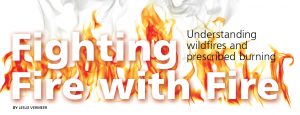Conversations
Understanding Wildfires and Prescribed Burning: Fighting Fire with Fire
BY LESLIE VERMEER
August, 2016
 Fire—mighty, wild and ever threatening to dance out of control—it’s one of humans’ most basic fears. Yet, appropriately harnessed, fire heats our homes, cooks our food, lets us enjoy technology and adds beauty to our lives. And thus is born a paradox.
Fire—mighty, wild and ever threatening to dance out of control—it’s one of humans’ most basic fears. Yet, appropriately harnessed, fire heats our homes, cooks our food, lets us enjoy technology and adds beauty to our lives. And thus is born a paradox.
Perhaps our primal fear of fire explains why prescribed burning—deliberately setting fire to landscapes—is such a divisive topic. The question rising to the top is this: Are prescribed burns a practical way to protect people and property from devastating wildfires, or do they unnecessarily destroy natural habitats? The answer involves a balance between the need to protect our communities and industries, and the realities of ecosystems that have evolved to burn.
What Is a Prescribed Burn?
According to Parks Canada, “A prescribed fire is an intentional fire planned and managed by fire specialists,” in a forested or grassland area. A prescribed burn imitates a wildfire but burns under controlled conditions so that both the area burned and the intensity of the fire are limited. While it may seem counterintuitive, burning is one way we keep forests healthy. Prescribed burns can be used to manage wildlife corridors and animal habitats, such as a burn near Rocky Mountain House National Historic Site this year, undertaken to improve the food source for the site’s resident bison. Prescribed burning may also be used to remove non-native, sometimes invasive, plants from an area.
Prescribed burning is just one tool in the larger job of forest management. Forest management refers to the many decisions forest stewards make to shape forests to balance various goals. A big part of forest management involves balancing economic goals against many competing interests and values, such as habitat for wildlife, recreational use of forested lands and aesthetic sensibilities—because let’s face it: cut blocks aren’t pretty.
A key element of today’s forest management is sustainable development, which refers to the premise that economic activities can be managed in ways the environment can support, so as not to waste, deplete or destroy natural resources. Prescribed burning is intended to make forestry sustainable by imitating the effects of natural fire. These effects include keeping insect pests in check and encouraging the growth of forbs (non-woody plants like lilies, buttercups and vetches), aspects of general forest succession.
Another important element of forest management is fire suppression, which means keeping wildfires from spreading. A wildfire is one that moves rapidly and destructively across large areas of forest or grassland. Suppression starts with fire spotting and encompasses activities like water bombing, ground fighting, applying fire-retardant chemicals and digging firelines. The point of fire suppression is to stop fire. Here in Alberta, stopping wildfires has ironically become one reason we need to consider prescribed -burning.
Differing Perspectives
Virtually all of Alberta is susceptible to wildfires. St. Albert and Sturgeon County lie in the parkland natural region, where fire is relatively infrequent, but are close to both the boreal forest and the montane (the Rocky Mountains and foothills) zones, where fire is a significant force on the landscape. The boreal forest is Alberta’s largest natural region, covering nearly 50 percent of the landmass, while the montane makes up another 17 percent. Alberta’s grassland—our hottest, driest terrain—encompasses 14 percent of the province. Alberta Agriculture and Forestry estimates Alberta’s Forest Protection Area at 38 million hectares. In short, there’s a lot to burn.
Forest fires burn about 28,000 square km of boreal forest across Canada annually. Because Alberta’s climate is drier than that of Ontario or Quebec, our forests tend to burn more often and with greater intensity than those in other regions, and climate change may amplify this intensity. Canada’s weather patterns are shifting as the globe warms. Current models predict a future with more electrical storms, which can start wildfires, and overall drier weather in western Canada, which increases the risk of wildfires.
If you’ve seen Bambi, you likely remember the scene in which animals race to escape the roaring, devouring wildfire. Fire, as Albertans know only too well, disrupts not only forests and wildlife but also human lives and livelihoods. Fighting wildfires is difficult, expensive and often dangerous. So it’s easy to understand why we want to prevent fires.
Here’s another angle to consider. According to the Canadian Parks and Wilderness Society (CPAWS), Canada’s boreal forest stores some 71 million tonnes of carbon. Given Alberta’s ongoing efforts to sequester carbon, our forests represent a tremendous resource for mitigating climate change. From that perspective, intentionally setting fire to the forest and releasing all that carbon seems wrongheaded. Yet fire is necessary to Alberta’s ecology. It is a natural form of disturbance that our forests and grasslands have experienced for millennia.
How We Got Here
Historically speaking, Alberta’s forests are fire dependent. Some of our most recognizable species, including lodgepole pine (Alberta’s provincial tree) and jack pine, need fire to regenerate. Others—trembling aspen, saskatoon and common fireweed, for example—thrive after fire, creating fresh food sources for various species and restarting the cycle of growth.
For thousands of years, most fires were caused by lightning strikes and burned freely until they ran out of fuel or met natural barriers such as rivers. Research shows that some aboriginal groups used fire strategically in forests and on grassland to manage plant and animal species. But Alberta’s ecological cycle began to change with the arrival of scientific forest management.
Forestry is an important part of Alberta’s economy. According to the Alberta Forest Products Association (AFPA), forestry is a $5-billion industry, directly employing some 15,000 people and supporting another 30,000 through spinoff employment. The industry harvests timber and turns wood and wood pulp into thousands of products we use every day, including paper, numerous chemicals, food products and more.
Because the forest is so economically valuable, for decades Alberta has been aggressive about fire suppression. One result of this regime is that in many parts of the province, the fuel load on wild lands is very high. That is, there’s a lot of organic matter that might have been recycled through burning and regeneration that is instead on the ground as snags (standing dead trees), windfalls (dead trees knocked down by wind) and very old living trees. More available fuel creates the potential for bigger, more intense fires that are challenging to fight.
At the same time, the province emphasizes the recreational values of our wild lands. Industrial development has made wilderness much more accessible, allowing Albertans to explore our beautiful province through camping, bird watching, fishing, hunting and other activities. The downside of access, however, is that human activity is the leading cause of wildfires, so fire suppression and prevention must remain a priority. Also, an increasing number of Albertans own residential properties, including vacation homes, in the boreal and montane zones. These owners want to keep their properties safe and expect fire suppression and property protection.
For some people, all burning, whether natural or intentional, is bad. The trouble is, humans have so fragmented the landscape that burning and habitat loss are inevitable. Many bird and animal species depend on extensive, continuous forest. Some, like the woodland caribou and the marten, need old-growth forest in particular to thrive. Intact forests are essential to a healthy, diverse environment. Because much of Alberta’s forested land has been disrupted—through forestry, but also through oil and gas exploration, pipelines, roads and other human encroachment—today’s forest is piecemeal at best. Environmental advocates demand habitat preservation and protection, including fire suppression in old-growth areas.
In Alberta, a forest’s typical lifespan is just 80 to 100 years. Some stands, through luck or intervention, may live much longer, however—for 200 years or more in some cases. From an industrial perspective, these stands are over-mature. There’s a limit to how long a forest can remain healthy in our climate, and the ecosystem of an over-mature forest is unhealthy. A large amount of organic matter accumulates on the forest floor; nutrients stop cycling efficiently and are trapped. Over millennia, fire has restored forests to health, but increasingly we refuse to let nature take its course.
That point leads to the crux issue. Because Alberta has used suppression so successfully in the past, we may now need prescribed burning to reduce the amount of burnable material on provincial lands. And because we face a future of more frequent, more intense wildfires, prescribed burning may be the tool we need to protect industrial sites, communities and wilderness itself. That is, to protect our forests, we must let them burn—-cautiously, in limited ways.
Is It Too Late?
A wildfire may release tonnes of carbon into the atmosphere as it burns organic matter. Carbon, in various gaseous forms, contributes to global warming. But that’s not the whole story.
Some of the carbon released by fire is quickly reabsorbed as plants, shrubs and trees regrow. This natural cycle has existed around the globe for millions of years. It is of concern today, however, because of human pressures on natural spaces and because of conflicting values regarding fire spread and fire suppression.
CPAWS describes forests as carbon dioxide sinks, part of humans’ larger strategy for managing climate change. The AFPA notes a 25-year-old pine tree will absorb 6.82 kg of carbon dioxide in a year. To put that in a larger context, “Over its 80-year life cycle, 1 hectare of pine sequesters 1.86 tonnes of carbon.” As Alberta tries to reduce its carbon emissions, reducing the amount of carbon released into the atmosphere by fire is vital.
Advocates say the thoughtful application of prescribed burning can prevent or contain future wildfires. This is the idea behind firebreaks, large spaces devoid of organic matter, which prevent wildfire from spreading, or at least slows it down. From this perspective, prescribed burning can reduce the amount of carbon released into the atmosphere by limiting the overall volume of organic matter burned in a given year.
The Sustainable Forest Management Network, based at the University of Alberta, reports that climate change could increase the amount of forest area burned in western Canada by 25 to 50 percent in coming decades. These fires may also burn hotter than past fires did. Intense fires destroy not only the forest but also the soil structure; they are also difficult to extinguish. Larger, hotter fires pose real environmental and social threats.
There isn’t a single, simple prescription, but forest management is necessarily at the centre of the interests and values that meet on our wild lands. Part of the issue comes down to land-use policy. The Alberta Forest Service position is that forests are a resource for humans to use and respect. How we use them is a matter for ongoing discussion among industries, land owners, various level of government and the public at large. But here’s the rub: we all lose if we make the wrong decisions.
The problem is randomness. We cannot control the weather or where and when lightning will strike. We also cannot control human behaviour, and accidents, arson and plain carelessness can all lead to fire. What we can do is try to moderate the consequences of the factors we cannot control. -Prescribed burning is one tool for doing so. t8n
Types of Fire
There are three types of forest fires.
Ground fires burn at or just below ground level and may smoulder for months, even years.
Surface fires burn the understory, from the ground to roughly two metres high.
Crown fires, the most dangerous, most destructive fires, burn at the tops of trees. Under the right conditions, fire can “jump” from one crown to another, enabling fire to spread rapidly. A forest fire may start as one type and evolve into another, or all three at once, if conditions permit.
The Sustainable Forest Management Network, based at the University of Alberta, reports that climate change could increase the amount of forest area burned in western Canada by 25 to 50 percent in coming decades.
According to the Alberta Forest Products Association (AFPA), forestry is a $5-billion industry, directly employing some 15,000 people and supporting another 30,000 through spinoff employment.
Be Fire Smart!
Humans cause most wildfires. Here are some ways you can reduce the risk.
Never build a fire during hot, windy weather.
Never throw cigarettes or matches from your vehicle when driving through rural or wilderness areas.
Keep trees, shrubs and grass around rural properties (including vacation homes) well trimmed and watered.
Never leave a campfire unattended. Douse it with water, and stir the ashes until they are cold before you leave your campsite.
Observe fire-condition notices in parks, and respect fire bans.
Report any unattended or out-of-control fires immediately.












